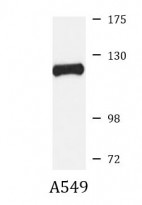ARG42750
anti-PKN1 antibody
anti-PKN1 antibody for Western blot and Human,Mouse
Overview
| Product Description | Rabbit Polyclonal antibody recognizes PKN1 |
|---|---|
| Tested Reactivity | Hu, Ms |
| Tested Application | WB |
| Host | Rabbit |
| Clonality | Polyclonal |
| Isotype | IgG |
| Target Name | PKN1 |
| Antigen Species | Human |
| Immunogen | Recombinant fusion protein corresponding to aa. 1-300 of Human PKN1 (NP_002732.3). |
| Conjugation | Un-conjugated |
| Alternate Names | Protein-kinase C-related kinase 1; DBK; Protein kinase C-like PKN; PKN-ALPHA; EC 2.7.11.13; Protease-activated kinase 1; Protein kinase PKN-alpha; PRK1; Protein kinase C-like 1; Serine-threonine protein kinase N; PRKCL1; PAK-1; PKN; PAK1; Serine/threonine-protein kinase N1 |
Application Instructions
| Application Suggestion |
|
||||
|---|---|---|---|---|---|
| Application Note | * The dilutions indicate recommended starting dilutions and the optimal dilutions or concentrations should be determined by the scientist. | ||||
| Positive Control | A549 | ||||
| Observed Size | ~ 120 kDa |
Properties
| Form | Liquid |
|---|---|
| Purification | Affinity purified. |
| Buffer | PBS (pH 7.3), 0.02% Sodium azide and 50% Glycerol. |
| Preservative | 0.02% Sodium azide |
| Stabilizer | 50% Glycerol |
| Storage Instruction | For continuous use, store undiluted antibody at 2-8°C for up to a week. For long-term storage, aliquot and store at -20°C. Storage in frost free freezers is not recommended. Avoid repeated freeze/thaw cycles. Suggest spin the vial prior to opening. The antibody solution should be gently mixed before use. |
| Note | For laboratory research only, not for drug, diagnostic or other use. |
Bioinformation
| Database Links |
Swiss-port # P70268 Mouse Serine/threonine-protein kinase N1 Swiss-port # Q16512 Human Serine/threonine-protein kinase N1 |
|---|---|
| Gene Symbol | PKN1 |
| Gene Full Name | protein kinase N1 |
| Background | The protein encoded by this gene belongs to the protein kinase C superfamily. This kinase is activated by Rho family of small G proteins and may mediate the Rho-dependent signaling pathway. This kinase can be activated by phospholipids and by limited proteolysis. The 3-phosphoinositide dependent protein kinase-1 (PDPK1/PDK1) is reported to phosphorylate this kinase, which may mediate insulin signals to the actin cytoskeleton. The proteolytic activation of this kinase by caspase-3 or related proteases during apoptosis suggests its role in signal transduction related to apoptosis. Alternatively spliced transcript variants encoding distinct isoforms have been observed. [provided by RefSeq, Jul 2008] |
| Function | PKC-related serine/threonine-protein kinase involved in various processes such as regulation of the intermediate filaments of the actin cytoskeleton, cell migration, tumor cell invasion and transcription regulation. Part of a signaling cascade that begins with the activation of the adrenergic receptor ADRA1B and leads to the activation of MAPK14. Regulates the cytoskeletal network by phosphorylating proteins such as VIM and neurofilament proteins NEFH, NEFL and NEFM, leading to inhibit their polymerization. Phosphorylates 'Ser-575', 'Ser-637' and 'Ser-669' of MAPT/Tau, lowering its ability to bind to microtubules, resulting in disruption of tubulin assembly. Acts as a key coactivator of androgen receptor (ANDR)-dependent transcription, by being recruited to ANDR target genes and specifically mediating phosphorylation of 'Thr-11' of histone H3 (H3T11ph), a specific tag for epigenetic transcriptional activation that promotes demethylation of histone H3 'Lys-9' (H3K9me) by KDM4C/JMJD2C. Phosphorylates HDAC5, HDAC7 and HDAC9, leading to impair their import in the nucleus. Phosphorylates 'Thr-38' of PPP1R14A, 'Ser-159', 'Ser-163' and 'Ser-170' of MARCKS, and GFAP. Able to phosphorylate RPS6 in vitro. [UniProt] |
| Cellular Localization | Cytoplasm. Nucleus. Endosome. Cell membrane; Peripheral membrane protein. Cleavage furrow. Midbody. Note=Associates with chromatin in a ligand-dependent manner. Localization to endosomes is mediated via its interaction with RHOB. Association to the cell membrane is dependent on Ser-377 phosphorylation. Accumulates during telophase at the cleavage furrow and finally concentrates around the midbody in cytokinesis. [UniProt] |
| Calculated MW | 104 kDa |
| PTM | Autophosphorylated; preferably on serine. Phosphorylated during mitosis. Activated by limited proteolysis with trypsin. (Microbial infection) In case of infection, polyubiquitinated by the bacterial E3 ubiquitin-protein ligase SspH1, leading to its proteasomal degradation. [UniProt] |
Images (1) Click the Picture to Zoom In






